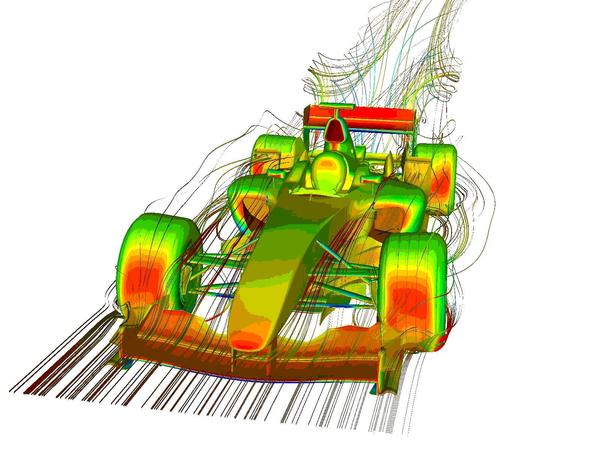In the fast-paced and highly competitive world of Formula 1 racing, innovation isn’t just a desirable trait – it’s an absolute necessity. Each year, engineers and designers are tasked with pushing the boundaries of technology to create the fastest and most advanced cars on the planet. But behind the sleek and aerodynamic exteriors lie a myriad of technical challenges that must be overcome.
From optimizing fuel efficiency to harnessing the power of hybrid engines, F1 car design requires a delicate balance of engineering expertise and cutting-edge technology. The pursuit of speed requires constant innovation in areas such as suspension systems, aerodynamics, and tire design. These technical challenges are what make Formula 1 so thrilling and captivating for both fans and tech enthusiasts.
In this article, we dive into the fascinating world of F1 car design and explore the technical hurdles that teams face. From the intricate aerodynamic components to the advanced materials used, we’ll uncover the innovation behind these remarkable machines and discover how they continue to push the boundaries of what’s possible in the world of automotive engineering. Join us and get ready for a thrilling ride into the heart of Formula 1 innovation.
The role of innovation in F1 car design
At the heart of Formula 1 car design lies the pursuit of innovation. Teams constantly strive to find new ways to gain a competitive edge, whether it’s through aerodynamics, powertrain design, or materials and construction techniques. Innovation in F1 car design not only leads to faster lap times and improved performance, but it also drives advancements in the wider automotive industry.
Technical challenges in F1 car design
Designing an F1 car is no easy task. Engineers and designers face a range of technical challenges that must be overcome in order to create a winning machine. One of the biggest challenges is optimizing fuel efficiency without sacrificing speed. F1 cars are highly fuel-efficient, thanks in part to their hybrid powertrains, which combine a traditional internal combustion engine with an electric motor. Balancing the power output of these two systems is crucial to achieving maximum performance.
Aerodynamics is another key technical challenge in F1 car design. The sleek and aerodynamic shape of an F1 car allows it to cut through the air with minimal drag, enabling it to reach incredible speeds. However, creating this aerodynamic profile requires careful design and engineering. Every surface of the car, from the front wing to the rear diffuser, must be optimized to create the perfect balance of downforce and drag.
Aerodynamics in F1 car design

Aerodynamics plays a crucial role in the performance of an F1 car. The goal is to maximize downforce.
This pushes the car onto the track, providing better traction and allowing for higher cornering speeds. At the same time, minimizing drag is essential to achieve maximum straight-line speed.
Achieving the right balance between downforce and drag is a delicate art.
It requires extensive wind tunnel testing and computational fluid dynamics simulations.
One of the key components of an F1 car’s aerodynamics is the front wing. The shape and design of the front wing are critical in directing the airflow around the car and generating downforce. Teams spend countless hours optimizing the shape and angle of the front wing to ensure it performs at its best.
Engine and powertrain design in F1 cars
The engine is the heart of any car, and F1 cars are no exception. In recent years, F1 has transitioned to hybrid powertrains, which combine a traditional internal combustion engine with an electric motor. This hybrid system not only improves fuel efficiency but also provides an additional boost of power.
The engine and powertrain of an F1 car must be designed to withstand the extreme demands of racing. They need to deliver high levels of power and torque while remaining reliable and durable. Achieving this balance requires innovative design and the use of lightweight materials such as carbon fiber and titanium.
Materials and construction techniques in F1 car design
The materials used in F1 car design are carefully selected for their strength, lightness, and durability. Carbon fiber composites are the material of choice for many components, including the monocoque – the structural chassis of the car. Carbon fiber offers an excellent strength-to-weight ratio. This allows for a lighter and stiffer chassis, which in turn improves handling and performance.
In addition to carbon fiber, other advanced materials such as titanium and magnesium are used in various components of an F1 car. These materials offer excellent strength and weight properties, making them ideal for applications where weight reduction is critical. Innovative construction techniques, such as additive manufacturing (3D printing), are also being explored to further enhance the performance and efficiency of F1 cars.
Safety considerations in F1 car design
Safety is of paramount importance in F1 car design. Over the years, significant strides have been made to improve driver safety and reduce the risk of injury in the event of an accident. The introduction of features such as the halo cockpit protection system and increased crash safety standards have helped to make F1 cars safer than ever before.
Crash testing plays a crucial role in ensuring the safety of F1 cars. Cars must undergo rigorous testing to meet stringent safety standards and regulations. These tests simulate various crash scenarios to assess the structural integrity of the car and the effectiveness of safety features.
The impact of technology on F1 car design
Technology plays a vital role in the design and development of F1 cars. Advanced simulation tools, such as computational fluid dynamics (CFD) and finite element analysis (FEA), allow engineers to model and optimize various aspects of the car’s performance. These tools enable teams to simulate airflow, predict structural behavior, and fine-tune the design before a physical prototype is built.
Data analysis and telemetry systems are also crucial in F1 car design. During a race, teams collect vast amounts of data from sensors placed throughout the car. This data is then analyzed in real-time to monitor performance, identify areas for improvement, and make strategic decisions during the race.
The future of F1 car design
The world of F1 car design is constantly evolving. As technology advances and new materials and techniques are developed, the possibilities for innovation are endless. Looking ahead, we can expect to see further advancements in areas such as aerodynamics, powertrain design, and materials science.
One area of particular interest is the development of sustainable technologies in F1 car design. With the increasing focus on environmental sustainability, teams are exploring ways to reduce their carbon footprint and improve the efficiency of their cars. This includes the use of alternative fuels, energy recovery systems, and lightweight materials.
Conclusion
The technical challenges behind F1 car design are immense, but so too are the rewards. Each year, teams push the boundaries of what’s possible in automotive engineering, creating machines that are faster, more efficient, and safer than ever before. The pursuit of innovation in F1 car design not only drives advancements in the sport but also inspires technological progress in the wider world of automobiles. As we look to the future, it’s clear that the technical challenges and innovation in F1 car design will continue to captivate and thrill both fans and tech enthusiasts alike.

